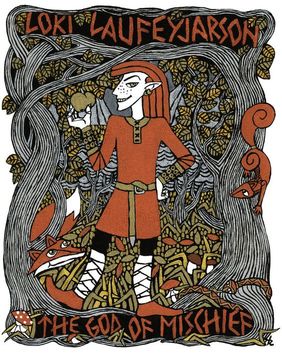The Mythological Mess: Archetypes in Action | Escape EDU
Review this page for clues. There is no need to review the other links (i.e. home, about, etc.) on this site, just content on this page and links and content within.

TRICKSTERS..... In many cultures, (as may be seen in Greek, Norse or Slavic folktales, along with Native American/First Nations lore), the trickster and the culture hero are often combined. The Tricksters of Mythology exhibit a great degree of intellect or secret knowledge, and uses it to play tricks or otherwise disobey normal rules and conventional behaviour.
It is suggested by Hansen (2001) that the term "Trickster" was probably first used in this context by Daniel G. Brinton in 1885.
The trickster deity breaks the rules of the gods or nature, sometimes maliciously (for example, Loki) but usually with ultimately positive effects. Often, the rule-breaking takes the form of tricks or thievery. Tricksters can be cunning or foolish or both; they are often very funny even when considered sacred or performing important cultural tasks. In many cultures, (as may be seen in Greek, Norse or Slavic folktales, along with Native American/First Nations lore), the trickster and the culture hero are often combined. To illustrate: Prometheus, in Greek mythology, stole fire from the gods to give it to humans: though he is more of a culture hero than a trickster.
It is suggested by Hansen (2001) that the term "Trickster" was probably first used in this context by Daniel G. Brinton in 1885.
The trickster deity breaks the rules of the gods or nature, sometimes maliciously (for example, Loki) but usually with ultimately positive effects. Often, the rule-breaking takes the form of tricks or thievery. Tricksters can be cunning or foolish or both; they are often very funny even when considered sacred or performing important cultural tasks. In many cultures, (as may be seen in Greek, Norse or Slavic folktales, along with Native American/First Nations lore), the trickster and the culture hero are often combined. To illustrate: Prometheus, in Greek mythology, stole fire from the gods to give it to humans: though he is more of a culture hero than a trickster.
|
|
In many Native American and First Nations mythologies, the coyote (Southwestern United States) or raven (Pacific Northwest and coastal British Columbia) stole fire from the gods (stars or sun) and are more tricksters than culture heroes. This is primarily because of other stories involving these spirits: Prometheus was a Titan, whereas coyote and raven are usually seen as jokesters and pranksters.
The trickster is an important archetype in the history of man. He is a god, yet he is not. He is the wise-fool. It is he, through his creations that destroy, points out the flaws in carefully constructed societies of man. He rebels against authority, pokes fun at the overly serious, creates convoluted schemes, that may |
or may not work, plays with the Laws of the Universe and is sometimes his own worst enemy. He exists to question, to cause us to question not accept things blindly. He appears when a way of thinking becomes outmoded needs to be torn down built anew. He is the Destroyer of Worlds at the same time the savior of us all.
The Trickster is an example of a Jungian Archetype: The Fool. The Fool survives in modern playing cards as the Joker or Jester. In modern literature the trickster survivors as a character archetype, not necessarily supernatural or divine, therefore better described as a stock character.
The Trickster is an example of a Jungian Archetype: The Fool. The Fool survives in modern playing cards as the Joker or Jester. In modern literature the trickster survivors as a character archetype, not necessarily supernatural or divine, therefore better described as a stock character.
SCAN with QR Code Reader - for best view-ability, use tablet.




